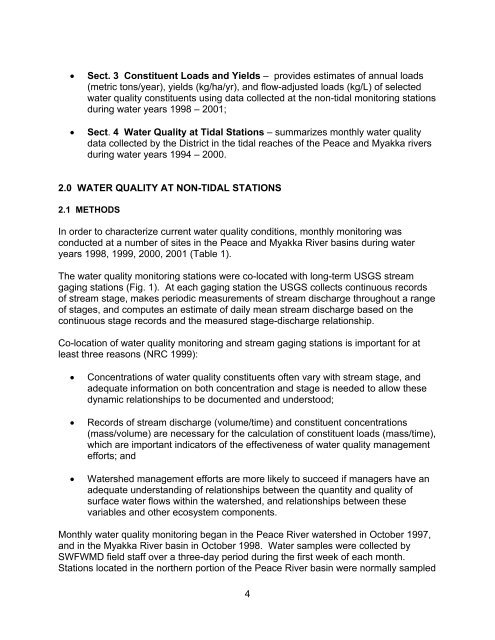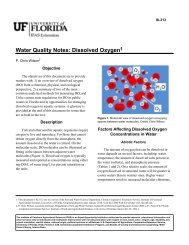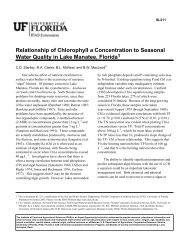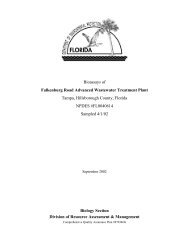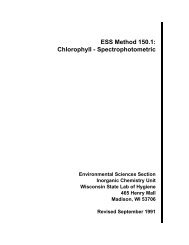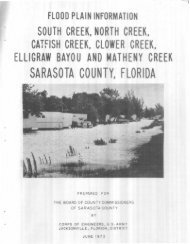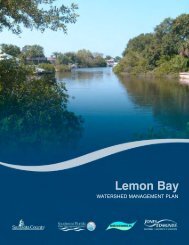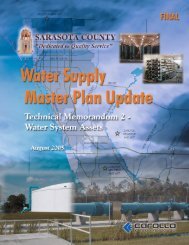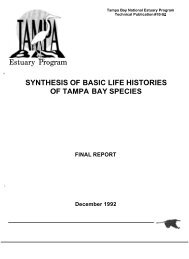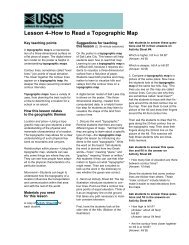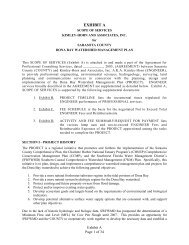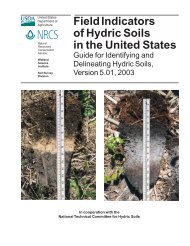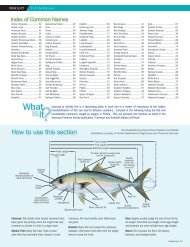Peace and Myakka River Water Quality Summary 2002 - Southwest ...
Peace and Myakka River Water Quality Summary 2002 - Southwest ...
Peace and Myakka River Water Quality Summary 2002 - Southwest ...
You also want an ePaper? Increase the reach of your titles
YUMPU automatically turns print PDFs into web optimized ePapers that Google loves.
• Sect. 3 Constituent Loads <strong>and</strong> Yields – provides estimates of annual loads(metric tons/year), yields (kg/ha/yr), <strong>and</strong> flow-adjusted loads (kg/L) of selectedwater quality constituents using data collected at the non-tidal monitoring stationsduring water years 1998 – 2001;• Sect. 4 <strong>Water</strong> <strong>Quality</strong> at Tidal Stations – summarizes monthly water qualitydata collected by the District in the tidal reaches of the <strong>Peace</strong> <strong>and</strong> <strong>Myakka</strong> riversduring water years 1994 – 2000.2.0 WATER QUALITY AT NON-TIDAL STATIONS2.1 METHODSIn order to characterize current water quality conditions, monthly monitoring wasconducted at a number of sites in the <strong>Peace</strong> <strong>and</strong> <strong>Myakka</strong> <strong>River</strong> basins during wateryears 1998, 1999, 2000, 2001 (Table 1).The water quality monitoring stations were co-located with long-term USGS streamgaging stations (Fig. 1). At each gaging station the USGS collects continuous recordsof stream stage, makes periodic measurements of stream discharge throughout a rangeof stages, <strong>and</strong> computes an estimate of daily mean stream discharge based on thecontinuous stage records <strong>and</strong> the measured stage-discharge relationship.Co-location of water quality monitoring <strong>and</strong> stream gaging stations is important for atleast three reasons (NRC 1999):• Concentrations of water quality constituents often vary with stream stage, <strong>and</strong>adequate information on both concentration <strong>and</strong> stage is needed to allow thesedynamic relationships to be documented <strong>and</strong> understood;• Records of stream discharge (volume/time) <strong>and</strong> constituent concentrations(mass/volume) are necessary for the calculation of constituent loads (mass/time),which are important indicators of the effectiveness of water quality managementefforts; <strong>and</strong>• <strong>Water</strong>shed management efforts are more likely to succeed if managers have anadequate underst<strong>and</strong>ing of relationships between the quantity <strong>and</strong> quality ofsurface water flows within the watershed, <strong>and</strong> relationships between thesevariables <strong>and</strong> other ecosystem components.Monthly water quality monitoring began in the <strong>Peace</strong> <strong>River</strong> watershed in October 1997,<strong>and</strong> in the <strong>Myakka</strong> <strong>River</strong> basin in October 1998. <strong>Water</strong> samples were collected bySWFWMD field staff over a three-day period during the first week of each month.Stations located in the northern portion of the <strong>Peace</strong> <strong>River</strong> basin were normally sampled4


